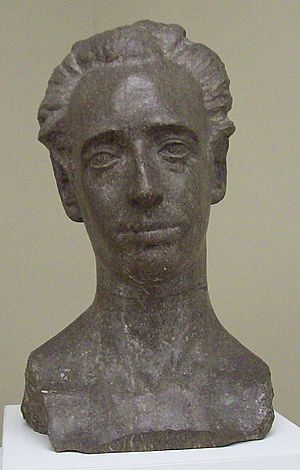Óscar Esplá facts for kids
Quick facts for kids
Óscar Esplá y Triay
|
|
|---|---|

Bust of Óscar Esplá by Vicente Bañuls, 1923
|
|
| Born | 5 August 1886 |
| Died | 6 January 1976 (aged 89) Madrid, Spain
|
| Nationality | Spanish |
| Other names | Óscar Esplá |
| Occupation | composer |
| Signature | |
 |
|
Óscar Esplá y Triay (born August 5, 1886 – died January 6, 1976) was a famous Spanish composer. A composer is someone who writes music.
The main music school in Alicante, Spain, is named after him. It is called the Conservatorio Superior de Música. Also, a special award for music writing, the Premio internacional de composición Óscar Esplá, was started in 1955. The city of Alicante gives out this award.
Contents
Life Story of Óscar Esplá
Early Life and Studies
Óscar Esplá was born in Alicante, Spain, on August 5, 1886. He started learning music from his father, Trino Esplá. He also had other music teachers, Fernando Lloret and Juan Latorre Baeza.
In 1903, he moved to Barcelona to study engineering. But he soon changed his mind and decided to study philosophy instead. He also learned how to compose music from Francisco Sánchez Gavagnac.
Travels and New Ideas
In 1911, Óscar Esplá won an international music prize. This allowed him to travel to Austria and Germany. He met other important musicians like Ferdinand Löwe in Vienna and Max Reger in Meiningen.
From 1912 to 1913, he lived in Paris, France. He met the famous composer Saint-Saëns there. These travels helped him learn new things and develop his own musical style.
Challenges and Return to Spain
In 1936, Óscar Esplá was chosen to be the director of a big music school in Madrid. It was called the Conservatorio Nacional de Música y Declamación. However, he could not take the job.
At that time, the Spanish Civil War started in Spain. Because of the war, he and his family had to leave Spain. They went to Belgium, where he worked for a newspaper called Le Soir. He was not allowed to return to Spain until 1950.
Óscar Esplá was part of a group of Spanish composers. This group was known as the "Grupo de los cuatro," which means "Group of the Four." Other members included Roberto Gerhard and Frederic Mompou.
Óscar Esplá passed away in Madrid on January 6, 1976. He was buried in a church in Alicante, at the Monasterio de la Santa Faz.
Awards and Recognition
Óscar Esplá received many awards for his musical talents. On May 9, 1956, he was chosen to be a member of the Académie des Beaux-Arts in Paris. This is a very respected art academy.
In 1959, he received a high honor from Spain. It was called the Grand Cross of the Orden de Alfonso X el Sabio. In 1965, he became an honorary member of the International Society for Contemporary Music. This shows how important his music was around the world.
Musical Works
Óscar Esplá wrote many different types of music. Here are some of his well-known works:
- El sueño de Eros (1910) – This is a symphonic poem, which is a piece of music that tells a story or describes something.
- Suite levantina (1911)
- La nochebuena del diablo (1923) – This is a cantata, a piece of music for singers and instruments.
- Don Quijote velando las armas (1924) – Another symphonic poem, inspired by the famous story of Don Quijote.
- Himno republicano (1931) – This music helped create the official version of the Himno de Riego, a national anthem.
- Tres Canciones (1952) – This means "Three Songs."
- Sinfonía Aitana (1964) – This is a symphony, a long piece of music for an orchestra.
See also
 In Spanish: Óscar Esplá para niños
In Spanish: Óscar Esplá para niños

